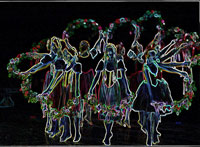To
the Pointe: It’s Time to Start Dancing!
Energetic, motivated, driven, disciplined, interested… words you want to use when you are talking
about your kid. How can you contribute to these positive traits in your
child? While the “nurture vs. nature” debate may continue, clearly
as a parent you want to give as much as you can to the nurture side. Some kids,
it’s true, are born with it; but without the support and care from parents, any natural ability, vocation or skill will not thrive. When these thrive, however,
self-assuredness comes fast behind and those positive words that this article started with will follow.
A
relationship between arts education, academic achievement, and character building is not just anecdotal. There is plenty of scientific evidence that getting your kids involved in artistic activities contributes
to other positive outcomes such as discipline, self-confidence, and higher academic achievement. Research studies demonstrate that the arts (including dance, drama, music, multiple arts, and visual arts)
provide mental links for students to develop crucial thinking skills and motivations they need to achieve at higher levels
in and out of school. A recent report published by the Arts and EDucation Partnership reviews more than 2,000 studies regarding arts and education
outcomes, including several academic peer-reviewed reports on the relationship between dance education and students academic
achievement. These studies, published in as diverse outlets such as the Journal
of Abnormal Child Psychology and the Journal of Aesthetic Education, outline that
dance, like other types of art education, enhances reading and language development, spatial reasoning and understanding of
mathematical concepts, fundamental thinking skills, motivation and social behavior.
Dancing enhances and complements reading
instruction by associating letters, words, and phrases with movements, sounds, and meanings. Like music instruction, dance
instruction develops spatial reasoning and spatial-temporal reasoning skills, which are fundamental for understanding and
using mathematical ideas and concepts. Dance, music, and other forms of art activities
improve social behavior and nurtures motivation, including active engagement, disciplined and sustained attention, persistence,
social tolerance and risk-taking, increasing also regular school attendance and retention, educational aspirations and community
engagement.
Dance helps in the formation of a positive personality with a strong work ethic, good teamwork and spirit, independence
and drive to achieve personal bests. Further, studies have shown that for certain populations -- students from economically disadvantaged circumstances, students
needing remedial instruction, and young children -- the effects of dance instruction may be especially robust and able
to boost learning and achievement. Ironically, however, when we think that this evidence will compel educators to think twice
before cutting the arts if their goal is to increase student academic achievement, Florida is implementing a 3-year high school
option that considers art and physical education superfluous. Outrageous (but the topic of another article).
Dancing
is positive also as a bonding parental experience, creating memories of shared activities toward a goal, such as a recital,
a performance or a competition. The scrambling of rehearsal and practice schedules, fund raising, costume mending, program
printing, etc., creates a special bond between all involved, shared afterwards in photographs, videos, programs and other
mementos that will be treasured forever. Special friendships are made between children with common interests and parents that would otherwise would not
have met.
Often
I am asked, “When can my daughter start dance lessons?” or, conversely, “Is it too late for my son or daughter
to start dancing?” In practice, this depends primarily on a single factor:
the inclination and interests of your child. To be part of dancing, at any age,
many opportunities exist in South Florida. There are dance academies that will
take children as early as two years old for creative movement activities. On
the other hand, many academies have teen and adult classes from beginners to advanced levels.
Some professional Broadway dancers started going to dance academies after high school!
And there are tappers and hoofers, even professional ballet dancers, that started in their twenties. A recent article in a regional newspaper showcased a recital held in the Hollywood Performing Arts Center,
of adult dancers between 30 and 60 years old. Many establishments in our area offer adult classes for people who want to maintain
their vitality and energy with a fun physical activity, and it doesn’t have to be just ballet, jazz or tap; there is
modern dance, lyrical, hip-hop, Latin dance, ballroom dancing, swing, flamenco, belly dancing, you name it!
Dancing is a positive experience that leads to energy, motivation, drive, discipline, and interest in
life, community, participation, and celebration for all. Right now is as good
a time to start!

